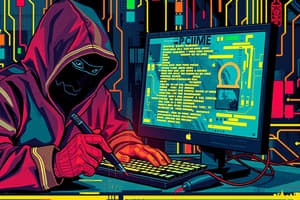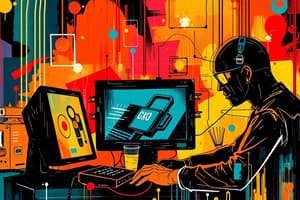Podcast
Questions and Answers
What is one reason why computer crime is more complicated to investigate than traditional crime?
What is one reason why computer crime is more complicated to investigate than traditional crime?
- Inconsistent international cooperation (correct)
- Criminals always leave physical evidence
- All computer crimes are easy to detect
- Victims are always individuals
Jurisdiction in computer crimes is only based on the location of the crime.
Jurisdiction in computer crimes is only based on the location of the crime.
False (B)
Name one early form of computer crime mentioned.
Name one early form of computer crime mentioned.
Theft of physical technology or sabotage.
The degree of technical sophistication of computer criminals can be represented as a __________.
The degree of technical sophistication of computer criminals can be represented as a __________.
Match the computer crime incident to its description:
Match the computer crime incident to its description:
Which of the following represents a difficulty in prosecuting computer crimes?
Which of the following represents a difficulty in prosecuting computer crimes?
Hacking generally requires less technological expertise than email fraud.
Hacking generally requires less technological expertise than email fraud.
What is steganography used for?
What is steganography used for?
The self-replicating computer program known as the __________ was released by Robert Morris.
The self-replicating computer program known as the __________ was released by Robert Morris.
What problem arises from the delay in the detection of computer crimes?
What problem arises from the delay in the detection of computer crimes?
Which of the following was NOT mentioned as an early hacker?
Which of the following was NOT mentioned as an early hacker?
Phreaking refers to the manipulation of telecommunications carriers for legal purposes.
Phreaking refers to the manipulation of telecommunications carriers for legal purposes.
What is the term used for inexperienced hackers who utilize existing scripts to exploit vulnerabilities?
What is the term used for inexperienced hackers who utilize existing scripts to exploit vulnerabilities?
Hacking originally involved role-playing games and was conducted by young, socially inept individuals fascinated with _______.
Hacking originally involved role-playing games and was conducted by young, socially inept individuals fascinated with _______.
Which motivation for hacking is associated with economic goals and theft?
Which motivation for hacking is associated with economic goals and theft?
The term 'cracker' refers to benign hackers who search for computer shortcuts.
The term 'cracker' refers to benign hackers who search for computer shortcuts.
What are 'call-sell' operations related to in the context of hacking?
What are 'call-sell' operations related to in the context of hacking?
Match the hacking terms to their definitions:
Match the hacking terms to their definitions:
What is one of the most dangerous sources of cybersecurity threats?
What is one of the most dangerous sources of cybersecurity threats?
The _______ market consists of businesses engaging in questionable practices without necessarily being illegal.
The _______ market consists of businesses engaging in questionable practices without necessarily being illegal.
What is one reason for the complexity in investigating computer crimes?
What is one reason for the complexity in investigating computer crimes?
All computer crimes are subject to the same jurisdictional laws regardless of where the criminal or victim is located.
All computer crimes are subject to the same jurisdictional laws regardless of where the criminal or victim is located.
Name a historical early form of computer crime.
Name a historical early form of computer crime.
The ____________ is a self-replicating program that caused significant damage in 1988.
The ____________ is a self-replicating program that caused significant damage in 1988.
Match the following computer crime incidents with their descriptions:
Match the following computer crime incidents with their descriptions:
What challenge does encryption present to prosecutors in computer crimes?
What challenge does encryption present to prosecutors in computer crimes?
Steganography is used for openly sharing information.
Steganography is used for openly sharing information.
What factor can increase the likelihood of escaping prosecution for computer crimes?
What factor can increase the likelihood of escaping prosecution for computer crimes?
__________ among nations can hinder the investigation and prosecution of computer crimes.
__________ among nations can hinder the investigation and prosecution of computer crimes.
Which of the following best describes the targets of computer crimes?
Which of the following best describes the targets of computer crimes?
Which of the following is NOT a motivation for contemporary hacking?
Which of the following is NOT a motivation for contemporary hacking?
Script kiddies are highly experienced hackers who understand the programs they use.
Script kiddies are highly experienced hackers who understand the programs they use.
What term is used to describe manipulation of telecommunications carriers to gain knowledge or services?
What term is used to describe manipulation of telecommunications carriers to gain knowledge or services?
Hackers who wreak havoc on the Internet are referred to as __________.
Hackers who wreak havoc on the Internet are referred to as __________.
Match the following hacker types with their descriptions:
Match the following hacker types with their descriptions:
Which method is commonly used in social engineering?
Which method is commonly used in social engineering?
The gray market involves strictly illegal activities.
The gray market involves strictly illegal activities.
What initial activities did early hackers engage in?
What initial activities did early hackers engage in?
The sale of credit card numbers is an example of __________ piracy.
The sale of credit card numbers is an example of __________ piracy.
In the context of hacking, what does the term 'cracker' refer to?
In the context of hacking, what does the term 'cracker' refer to?
Which of the following was known as the first teen to be incarcerated for hacking?
Which of the following was known as the first teen to be incarcerated for hacking?
Social engineering includes methods such as shoulder surfing and stealing codes while dialing.
Social engineering includes methods such as shoulder surfing and stealing codes while dialing.
What is the term used for inexperienced hackers who do not understand the programs they exploit?
What is the term used for inexperienced hackers who do not understand the programs they exploit?
Phreaking refers to the manipulation of ________ carriers to gain knowledge or services.
Phreaking refers to the manipulation of ________ carriers to gain knowledge or services.
Match the motivations for hacking with their descriptions:
Match the motivations for hacking with their descriptions:
Which of the following hackers was known for breaking and entering into U.S. Missile Command?
Which of the following hackers was known for breaking and entering into U.S. Missile Command?
The gray market refers to strictly illegal activities being conducted by legitimate businesses.
The gray market refers to strictly illegal activities being conducted by legitimate businesses.
What device was used to deceive switching systems for free calls?
What device was used to deceive switching systems for free calls?
Early hackers were often referred to as ________ when their intentions were criminal.
Early hackers were often referred to as ________ when their intentions were criminal.
Match the types of hackers with their descriptions:
Match the types of hackers with their descriptions:
What is a significant obstacle when investigating computer crimes internationally?
What is a significant obstacle when investigating computer crimes internationally?
Encryption makes it easier for prosecutors to secure convictions in computer crime cases.
Encryption makes it easier for prosecutors to secure convictions in computer crime cases.
Name a historical early form of computer crime?
Name a historical early form of computer crime?
The self-replicating program that caused significant damage in 1988 is known as the __________.
The self-replicating program that caused significant damage in 1988 is known as the __________.
Match the following computer crime-related terms with their definitions:
Match the following computer crime-related terms with their definitions:
Which of the following best describes the targets of computer crimes?
Which of the following best describes the targets of computer crimes?
Anonymity can encourage individuals to commit computer crimes.
Anonymity can encourage individuals to commit computer crimes.
What can significantly complicate the prosecution of computer crimes?
What can significantly complicate the prosecution of computer crimes?
The self-named __________ of Doom is associated with the crash of the AT&T telephone system.
The self-named __________ of Doom is associated with the crash of the AT&T telephone system.
What constitutes an important factor in defining computer crimes?
What constitutes an important factor in defining computer crimes?
Flashcards are hidden until you start studying
Study Notes
Technical Sophistication of Computer Criminals
- Computer criminals exhibit a continuum of offenses based on their technical skills.
- Investigative agencies' technical expertise impacts the handling of computer crimes.
Jurisdictional Challenges
- Jurisdiction for crimes typically relies on the crime's location, complicating computer crime cases which can span multiple regions.
- Local laws may conflict if criminals and victims reside in different jurisdictions.
International Cooperation
- Lack of international collaboration hampers the investigation and prosecution of computer crimes.
- Cultural skepticism and inconsistent judicial approaches further complicate cross-border efforts.
Encryption and Anonymity
- Tools like cryptography and steganography make it difficult to detect and prosecute cybercriminals.
- Perception of anonymity can encourage criminal behavior, as offenders may hide their identities.
Defining Computer Crimes
- The nature of victims varies; they can be individuals, organizations, or nations.
- The methods and technology involved differ significantly across types of attacks, from hacking to fraud.
Historical Context of Computer Crime
- Early computer crime included physical theft (e.g., abacus) and sabotage (e.g., destruction of Jacquard's machine).
- Significant events include:
- 1986: KGB hacker breaches MILNET, discovered by UC Berkeley programmer.
- 1988: Robert Morris releases the Morris Worm, infecting over 6000 computers.
- AT&T crash due to software failure linked to the Legion of Doom, investigated by the Secret Service.
Early Hackers
- Kevin Mitnick: Notable hacker notorious for various offenses.
- First teenage hacker, known as cOmrade, incarcerated for his activities.
- Other early influencers include Terminus, Shadowhawk, and Kyrie.
Phreaking
- Involves manipulating telecommunications systems for knowledge or theft of services.
- Techniques included social engineering and blue box devices for free calls.
Evolution of Hacking Culture
- Initial hacking in the 1960s was benign, focused on creativity and problem-solving.
- Shifted towards criminal activities, with the term "cracker" coined for malicious hackers.
Motivations of Hackers
- Profit and economic gain remain primary motives for many cybercriminals.
- Other motives include revenge, personal notoriety, boredom, informational curiosity, and political agendas.
Types of Hackers
- Script kiddies: Inexperienced hackers using existing tools without understanding their workings.
- Cyberpunks: A law enforcement term for disruptive internet users, diverging from the original benign use.
Threat Levels
- Hackers and crackers are categorized as sophisticated criminals, while organized cybercrime poses a greater threat.
- Insiders can be the most significant risk, requiring robust security awareness training.
Market Dynamics
- Black market activities involve organized crime, while the gray market includes businesses engaging in questionable practices.
- Data piracy extends to stolen credit card information, software, and intellectual property like patents and trademarks.
Piracy and Counterfeiting
- Film and television piracy is prevalent through illegal copying of media.
- Internet piracy includes signal theft, while technology piracy involves counterfeiting critical hardware components.
Technical Sophistication of Computer Criminals
- Computer criminals exhibit a continuum of offenses based on their technical skills.
- Investigative agencies' technical expertise impacts the handling of computer crimes.
Jurisdictional Challenges
- Jurisdiction for crimes typically relies on the crime's location, complicating computer crime cases which can span multiple regions.
- Local laws may conflict if criminals and victims reside in different jurisdictions.
International Cooperation
- Lack of international collaboration hampers the investigation and prosecution of computer crimes.
- Cultural skepticism and inconsistent judicial approaches further complicate cross-border efforts.
Encryption and Anonymity
- Tools like cryptography and steganography make it difficult to detect and prosecute cybercriminals.
- Perception of anonymity can encourage criminal behavior, as offenders may hide their identities.
Defining Computer Crimes
- The nature of victims varies; they can be individuals, organizations, or nations.
- The methods and technology involved differ significantly across types of attacks, from hacking to fraud.
Historical Context of Computer Crime
- Early computer crime included physical theft (e.g., abacus) and sabotage (e.g., destruction of Jacquard's machine).
- Significant events include:
- 1986: KGB hacker breaches MILNET, discovered by UC Berkeley programmer.
- 1988: Robert Morris releases the Morris Worm, infecting over 6000 computers.
- AT&T crash due to software failure linked to the Legion of Doom, investigated by the Secret Service.
Early Hackers
- Kevin Mitnick: Notable hacker notorious for various offenses.
- First teenage hacker, known as cOmrade, incarcerated for his activities.
- Other early influencers include Terminus, Shadowhawk, and Kyrie.
Phreaking
- Involves manipulating telecommunications systems for knowledge or theft of services.
- Techniques included social engineering and blue box devices for free calls.
Evolution of Hacking Culture
- Initial hacking in the 1960s was benign, focused on creativity and problem-solving.
- Shifted towards criminal activities, with the term "cracker" coined for malicious hackers.
Motivations of Hackers
- Profit and economic gain remain primary motives for many cybercriminals.
- Other motives include revenge, personal notoriety, boredom, informational curiosity, and political agendas.
Types of Hackers
- Script kiddies: Inexperienced hackers using existing tools without understanding their workings.
- Cyberpunks: A law enforcement term for disruptive internet users, diverging from the original benign use.
Threat Levels
- Hackers and crackers are categorized as sophisticated criminals, while organized cybercrime poses a greater threat.
- Insiders can be the most significant risk, requiring robust security awareness training.
Market Dynamics
- Black market activities involve organized crime, while the gray market includes businesses engaging in questionable practices.
- Data piracy extends to stolen credit card information, software, and intellectual property like patents and trademarks.
Piracy and Counterfeiting
- Film and television piracy is prevalent through illegal copying of media.
- Internet piracy includes signal theft, while technology piracy involves counterfeiting critical hardware components.
Technical Sophistication of Computer Criminals
- Computer criminals exhibit a continuum of offenses based on their technical skills.
- Investigative agencies' technical expertise impacts the handling of computer crimes.
Jurisdictional Challenges
- Jurisdiction for crimes typically relies on the crime's location, complicating computer crime cases which can span multiple regions.
- Local laws may conflict if criminals and victims reside in different jurisdictions.
International Cooperation
- Lack of international collaboration hampers the investigation and prosecution of computer crimes.
- Cultural skepticism and inconsistent judicial approaches further complicate cross-border efforts.
Encryption and Anonymity
- Tools like cryptography and steganography make it difficult to detect and prosecute cybercriminals.
- Perception of anonymity can encourage criminal behavior, as offenders may hide their identities.
Defining Computer Crimes
- The nature of victims varies; they can be individuals, organizations, or nations.
- The methods and technology involved differ significantly across types of attacks, from hacking to fraud.
Historical Context of Computer Crime
- Early computer crime included physical theft (e.g., abacus) and sabotage (e.g., destruction of Jacquard's machine).
- Significant events include:
- 1986: KGB hacker breaches MILNET, discovered by UC Berkeley programmer.
- 1988: Robert Morris releases the Morris Worm, infecting over 6000 computers.
- AT&T crash due to software failure linked to the Legion of Doom, investigated by the Secret Service.
Early Hackers
- Kevin Mitnick: Notable hacker notorious for various offenses.
- First teenage hacker, known as cOmrade, incarcerated for his activities.
- Other early influencers include Terminus, Shadowhawk, and Kyrie.
Phreaking
- Involves manipulating telecommunications systems for knowledge or theft of services.
- Techniques included social engineering and blue box devices for free calls.
Evolution of Hacking Culture
- Initial hacking in the 1960s was benign, focused on creativity and problem-solving.
- Shifted towards criminal activities, with the term "cracker" coined for malicious hackers.
Motivations of Hackers
- Profit and economic gain remain primary motives for many cybercriminals.
- Other motives include revenge, personal notoriety, boredom, informational curiosity, and political agendas.
Types of Hackers
- Script kiddies: Inexperienced hackers using existing tools without understanding their workings.
- Cyberpunks: A law enforcement term for disruptive internet users, diverging from the original benign use.
Threat Levels
- Hackers and crackers are categorized as sophisticated criminals, while organized cybercrime poses a greater threat.
- Insiders can be the most significant risk, requiring robust security awareness training.
Market Dynamics
- Black market activities involve organized crime, while the gray market includes businesses engaging in questionable practices.
- Data piracy extends to stolen credit card information, software, and intellectual property like patents and trademarks.
Piracy and Counterfeiting
- Film and television piracy is prevalent through illegal copying of media.
- Internet piracy includes signal theft, while technology piracy involves counterfeiting critical hardware components.
Studying That Suits You
Use AI to generate personalized quizzes and flashcards to suit your learning preferences.




